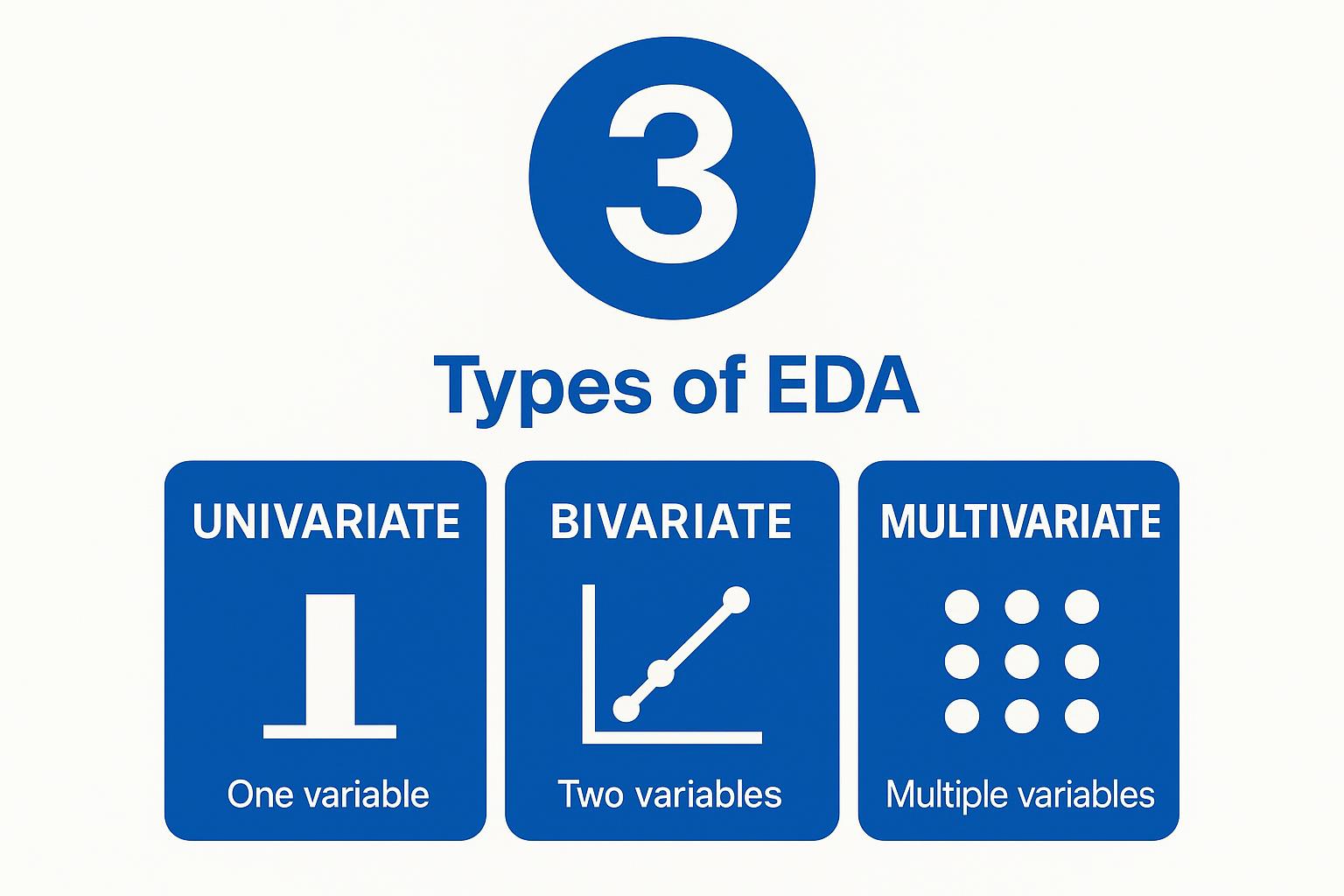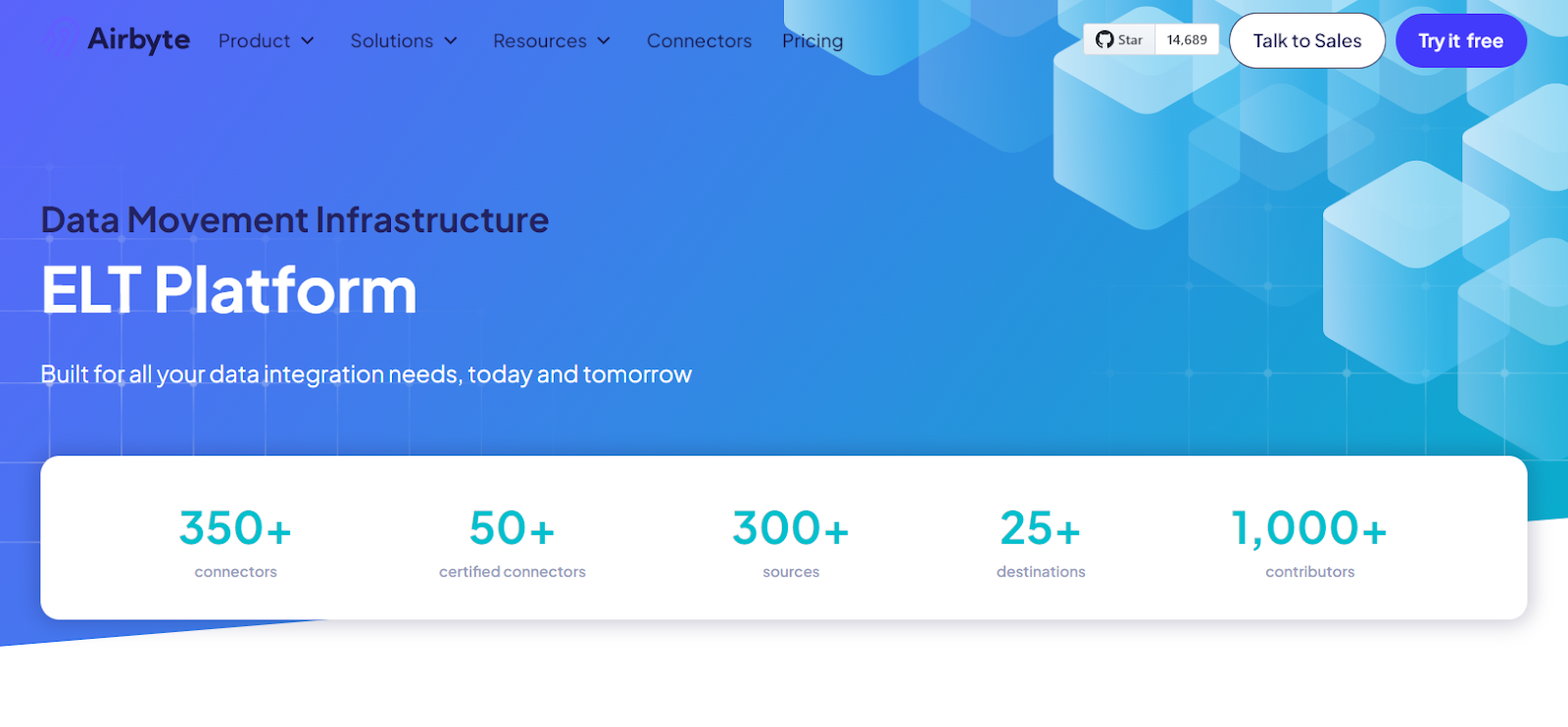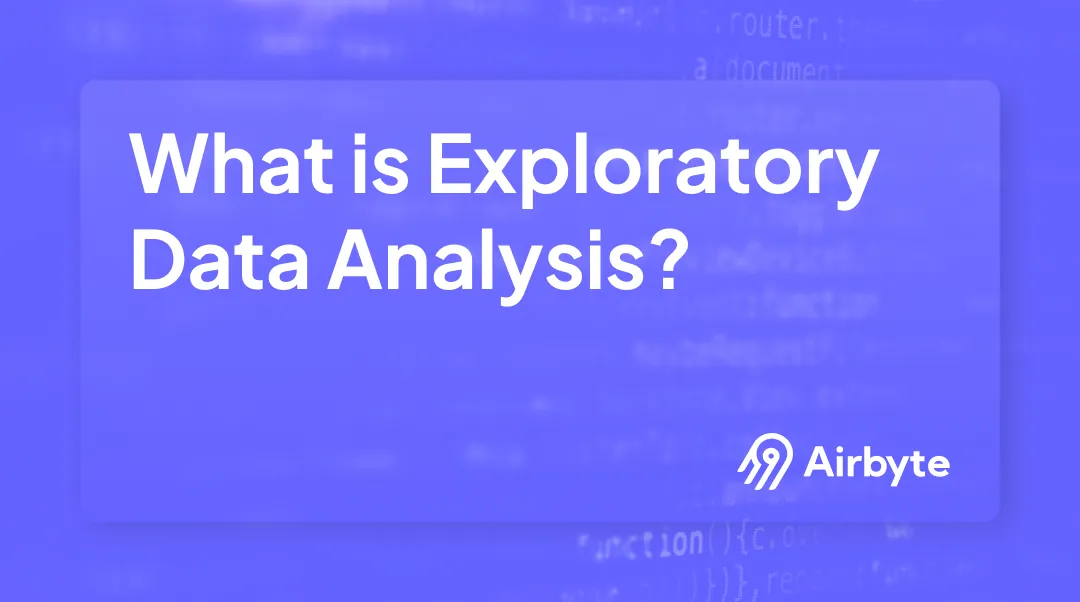What is Exploratory Data Analysis: Types, Tools, & Examples
Summarize this article with:
✨ AI Generated Summary
Exploratory Data Analysis (EDA) is essential for understanding data patterns, detecting anomalies, and guiding further analysis, evolving from basic statistics to AI-driven, automated frameworks that enhance speed and accuracy. Key aspects include:
- Types of EDA: univariate, bivariate, and multivariate analyses using graphical and non-graphical methods.
- AI-driven methodologies: automated pattern discovery, natural-language querying, predictive insight generation, and context-aware exploration.
- Systematic EDA process: data collection, cleansing, visualization, advanced analysis, interpretation, and reproducibility through documentation and containerization.
- Ethical frameworks: data anonymization, bias detection, privacy preservation, and validation checkpoints integrated throughout the workflow.
- Challenges: data integration, quality, scalability, privacy, bias, and high-dimensional complexity addressed by governance and advanced tools.
- Airbyte’s role: simplifies data integration with 600+ connectors, real-time sync, AI-powered pipeline creation, and enterprise-grade security, enabling focus on analysis over engineering.
Exploratory Data Analysis (EDA) serves as the critical foundation for data-driven decision making, enabling professionals to uncover patterns, detect anomalies, and formulate hypotheses before diving into complex modeling. As datasets grow in volume and complexity, EDA has evolved from simple statistical summaries to sophisticated AI-augmented processes that combine automation with human expertise to deliver faster, more accurate insights.
This comprehensive guide explores modern EDA methodologies, tools, and best practices that address today's analytical challenges. You'll discover how to leverage automated frameworks, AI-driven techniques, and advanced visualization methods to transform raw data into actionable intelligence while maintaining analytical rigor and reproducibility.
What Is Exploratory Data Analysis?
Understanding your data in depth before performing any analysis is essential for successful data science projects. You need to know the patterns, the variables, and how those variables relate to each other, among other things. Exploratory data analysis (EDA) is the systematic process that examines, summarizes, visualizes, and understands your data to generate data-driven conclusions and guide further investigation.
Summarizing the Data
EDA enables comprehensive data summarization using descriptive statistics, which helps understand the deviation, central tendency, and distribution of values across your dataset. This foundational step reveals the basic characteristics of your data, including measures of central tendency, variability, and shape of distributions.
Data Visualizing
By implementing EDA, you can utilize varied visualization techniques such as histograms, line charts, scatter plots, and advanced interactive visualizations to explore patterns, relationships, and trends within the dataset. Modern EDA incorporates dynamic visualizations that adapt to data characteristics automatically, with context-aware systems that recommend optimal chart types based on statistical properties of variables.
Data Cleansing
Data cleansing is crucial for driving meaningful insights and ensuring accuracy. EDA helps you clean your data by identifying errors, inconsistencies, duplicates, and missing values while providing frameworks for addressing these quality issues systematically. Contemporary approaches integrate automated quality assessment tools that flag potential issues and suggest remediation strategies based on data distribution characteristics.
What Are the Types of Exploratory Data Analysis?
Understanding exploratory data analysis techniques helps with efficient data analysis and meaningful decisions. Below are the three primary types that form the foundation of systematic data exploration.

1. Univariate Exploratory Data Analysis
A type of analysis in which you study one variable at a time to understand its distribution, central tendency, and variability. For example, focusing on product sales to understand which product performs better requires examining sales figures independently of other factors.
- Graphical Methods: histograms, box plots, density plots, violin plots, Q-Q plots
- Non-Graphical Methods: mean, median, mode, dispersion measures, percentiles, skewness, kurtosis
2. Bivariate Exploratory Data Analysis
Bivariate analysis focuses on studying relationships between two variables to understand correlation, causation, and interaction patterns. For example, exploring the relationship between customer age and product category preferences reveals important market segmentation insights.
- Graphical Methods: scatter plots, line charts, bubble charts, correlation matrices, joint distribution plots
- Non-Graphical Methods: correlation coefficients, regression analysis, chi-square tests, covariance calculations
3. Multivariate Exploratory Data Analysis
Multivariate analysis helps analyze and understand complex relationships between three or more variables simultaneously. For example, exploring the relationship between a person's height, weight, age, and health outcomes requires sophisticated analytical techniques to identify meaningful patterns.
- Graphical Methods: scatter-plot matrices, heat maps, parallel-coordinates plots, dimensionality-reduction visualizations
- Non-Graphical Methods: multiple regression, factor analysis, cluster analysis, principal component analysis
What Are AI-Driven Exploratory Data Analysis Methodologies?
Modern EDA has evolved beyond traditional statistical approaches to incorporate artificial intelligence and machine-learning techniques that automate pattern discovery and insight generation. These AI-driven methodologies transform reactive analysis into proactive intelligence extraction.
Automated Pattern Discovery
AI-enhanced EDA systems now leverage unsupervised learning algorithms to automatically identify clusters, anomalies, and feature relationships without human intervention. Machine learning algorithms like isolation forests enable automated anomaly detection, while topological data analysis reveals nonlinear manifolds in customer behavior datasets that conventional correlation matrices miss. These systems incorporate predictive imputation models for missing value handling, where algorithms not only fill gaps but quantify uncertainty distributions, creating more statistically robust foundations for downstream analysis.
Natural-Language Query Processing
Contemporary EDA platforms integrate large language models to enable conversational data exploration. You can now frame analytical queries in natural language such as "Show seasonal purchasing patterns among high-value customers" rather than constructing complex technical queries. These systems translate conversational prompts into executable code while maintaining full transparency for reproducibility. Advanced implementations generate comprehensive data narratives that explain not just what patterns exist but why they matter contextually, bridging the gap between statistical outputs and business intelligence.
Predictive Insight Generation
AI-driven EDA tools generate hypothesis briefs that automatically surface statistically significant relationships ranked by predictive strength and business relevance. These systems incorporate Bayesian surprise metrics to prioritize unexpected patterns. Automated feature engineering now generates feature interaction terms, polynomial expansions, and domain-specific transformations based on data characteristics and analysis goals, while maintaining human oversight through validation checkpoints where automated suggestions undergo statistical verification.
Context-Aware Exploration
Advanced implementations maintain conversation history to enable iterative questioning, where follow-up queries inherit context from previous analysis. Modern platforms generate hypothesis trees that propose multiple analytical pathways based on initial findings, creating dynamic exploration frameworks rather than static reports. This represents a fundamental shift from predetermined analysis scripts to adaptive exploration where each finding dynamically shapes subsequent investigative directions.
How Can You Perform Exploratory Data Analysis?
Modern EDA follows a systematic eight-step process that combines traditional statistical rigor with contemporary automated techniques to ensure comprehensive data understanding.
- Data Collection – Gather relevant data from assorted sources, ensuring quality and completeness with automated schema validation against domain-specific data contracts.
- Inspecting the Data Variables – Identify critical variables, data types, missing values, and initial distributions using AI-powered profiling tools that highlight potential quality issues.
- Data Cleansing – Remedy errors, inconsistencies, and duplicates while preserving data integrity through systematic transformation tracking and statistical justification documentation.
- Identifying Patterns and Correlations – Visualize datasets using different data visualization tools with automated chart selection based on variable characteristics.
- Performing Descriptive Statistics – Calculate measures of central tendency, variability, and distribution characteristics with automated hypothesis generation for analyst validation.
- Perform Advanced Analysis – Apply multivariate techniques and ML approaches to gain deeper insights, incorporating specialized methods for temporal, spatial, and unstructured data.
- Interpret Data – Generate insights within the appropriate business context using AI-assisted narrative generation that explains statistical patterns in business terms.
- Document and Report – Record steps, techniques, and findings for stakeholders through reproducible notebooks with version-controlled dependencies and comprehensive operation logs.
What Are Automated EDA Tools and Frameworks?
The evolution of EDA has been significantly accelerated by automated tools that reduce manual effort while maintaining analytical rigor. Contemporary implementations combine traditional statistical methods with cloud-native architectures and natural language interfaces.
Python-Based Automated Libraries
Libraries such as ydata-profiling represent the state-of-the-art in automated report generation, extending beyond basic statistics to provide time-series decomposition, text analytics, and dataset comparison features in a single HTML output. D-Tale has emerged as the premier interactive exploration environment, offering GUI-based data transformation capabilities with real-time code generation. AutoViz provides automated visualization selection tuned to statistical properties of variables, generating publication-quality plots with contextual annotations.
AI-Enhanced Exploration Platforms
Cloud-based EDA platforms have become essential infrastructure for enterprise analytics, offering scalable computation, collaborative environments, and integrated AI capabilities. These platforms incorporate data catalog integration where EDA findings automatically populate metadata repositories, creating institutional knowledge that accelerates future analyses. Leading implementations feature real-time collaboration environments where team members can simultaneously explore different dataset facets while maintaining a unified analysis narrative.
Enterprise-Grade Automated Solutions
Modern platforms incorporate automated data profiling with AI-assisted insight generation, enabling business analysts to conduct sophisticated exploration through conversational queries. These systems maintain automated assumption tracking where domain knowledge assertions are recorded in machine-readable formats and validated against data distributions throughout the analysis lifecycle.
Integration with ML Workflows
Modern frameworks integrate with ML pipelines, automatically generating feature-importance rankings, correlation analyses, and data-quality reports that inform model development. Execution frameworks like Kedro and Prefect have been adapted to manage exploratory workflows, providing dependency management and error handling traditionally reserved for production pipelines, significantly increasing analysis reliability.
What Are the Traditional Exploratory Data Analysis Tools You Can Use?
- Python – NumPy, Pandas, Scikit-learn, Seaborn, Plotly for comprehensive statistical computing and visualization
- R – Rich ecosystem for cleaning, transformation, and statistical exploration with specialized packages for domain-specific analysis
- MATLAB – Robust environment for numerical computations and visualizations with specialized toolboxes for engineering applications
- Jupyter Notebooks – Interactive, shareable documents that combine code, visualizations, and narrative text with extensions for automated reproducibility
What Ethical Frameworks Should Guide Exploratory Data Analysis?
Contemporary EDA practice requires systematic integration of ethical considerations throughout the exploration workflow, as traditional approaches often defer ethics to post-analysis phases when bias patterns have already been established.
Contextual Data Protection Protocols
Dynamic anonymization should trigger during data inspection based on field semantics and regulatory requirements. ZIP codes display as regions, salaries as quartiles, and medical codes as categorical flags without granular values to prevent individual re-identification. Modern implementations incorporate semantic tagging during data ingestion with pre-configured aggregation rules per data class and just-in-time transformation engines that maintain analytical utility while protecting sensitive information.
Automated Bias Detection Systems
Bias scoring accompanies standard summary statistics through automated fairness assessment tools that calculate demographic parity metrics for protected attributes, distributional divergence scores across subgroups, and counterfactual fairness simulators. These systems flag potential disparities before model development, enabling proactive remediation rather than reactive correction. Advanced platforms maintain bias budgets that quantitatively track protected class disparities introduced during data exploration phases.
Ethical Decision Trees and Validation Checkpoints
Structured workflow checkpoints mitigate ethical oversights through systematic validation frameworks. Procedural approaches ensure ethical considerations precede analytical insights by implementing mandatory review gates when protected attributes are detected, outcome disparities exceed threshold values, or sensitive data combinations require specialized handling protocols.
Privacy-Preserving Exploration Techniques
Differential privacy mechanisms enable statistical analysis while preventing individual data reconstruction through calibrated noise injection and privacy budget management. Contemporary platforms track cumulative privacy cost across exploration sessions while maintaining analytical utility through adaptive query optimization and intelligent sampling strategies that preserve population-level insights.
How Can You Ensure Reproducibility in Iterative EDA Processes?
EDA reproducibility requires systematic capture of exploration evolution, as traditional version control focuses on final artifacts rather than analytical pathways that generate insights.
Provenance-Aware Documentation Systems
Comprehensive exploration tracking requires three-layer documentation: raw computational notebooks with chronological execution records, parameterized pipeline definitions for critical transformations, and differential analysis lineage that flags divergent analytical paths across team members. Modern implementations automatically generate exploration chronicles that interweave code, visualizations, and narrative insights in reproducible notebooks with version-controlled dependencies.
Containerized Exploration Environments
Lightweight containerization enables exact environment recreation through dependency freezing and computational state preservation. When combined with Jupyter checkpoint extensions, MLflow artifact tracking, and data versioning systems, analysts achieve executable research compendiums where specific analysis checkpoints reliably regenerate interim visualizations months later. These frameworks eliminate the "works on my machine" problem through immutable research artifacts.
Automated State Management and Recovery
Progressive disclosure documentation replaces monolithic reports through interactive exploration widgets that maintain parameter states and analytical progression. Modern platforms implement exploration sprints where data scientists, domain experts, and business stakeholders co-navigate datasets in collaborative environments with automatically generated analysis transcripts that document conclusions and exploratory pathways, including discarded hypotheses.
Cross-Analysis Knowledge Synthesis
Advanced organizations maintain EDA knowledge bases that index exploration artifacts by dataset fingerprint, enabling semantic search across visualization images and narrative insights. These systems incorporate automated cross-analysis comparison where platforms identify contradictions or confirmations across multiple EDA artifacts, building institutional understanding beyond individual explorations through systematic methodology refinement.
What Are the Challenges of Exploratory Data Analysis?
Data Unification and Integration Complexity
Reconciling inconsistent data models from multiple sources complicates EDA preparation, requiring sophisticated schema mapping and transformation capabilities that preserve analytical context while enabling cross-system pattern detection.
Data Quality and Reliability Issues
Inconsistencies, missing values, outliers, and measurement errors can lead to flawed conclusions if not systematically addressed through comprehensive quality assessment frameworks and statistical validation procedures.
Scalability and Performance Limitations
High-volume datasets strain traditional EDA methods, preventing real-time analysis and requiring distributed computing frameworks that maintain interactive responsiveness while processing terabyte-scale information.
Security and Privacy Concerns
Sensitive data introduces risks of unauthorized access and compliance violations, necessitating advanced governance frameworks that enable exploration while protecting individual privacy and meeting regulatory requirements.
Subjectivity and Cognitive Bias
Human interpretation variants can introduce confirmation bias and pattern overfitting, requiring systematic validation mechanisms and collaborative review processes that maintain analytical objectivity.
Data Consistency and Versioning
Maintaining reproducibility while datasets evolve requires sophisticated version control systems that track both data evolution and analytical progression throughout exploration workflows.
High-Dimensional Data Complexity
The curse of dimensionality demands specialized algorithms and mathematical techniques that can identify meaningful patterns in complex feature spaces while avoiding spurious correlations.
Addressing these challenges requires adopting best practices for smooth data integration and systematic data-quality management through comprehensive governance frameworks.
How Can You Simplify the EDA Process with Airbyte?

Airbyte transforms exploratory data analysis by solving the fundamental data access and integration challenges that typically consume the majority of EDA preparation time. As the leading open-source data integration platform, Airbyte enables data teams to focus on analysis rather than data engineering overhead.
AI-Optimized Data Pipeline Creation
Airbyte's 600+ pre-built connectors eliminate custom integration development, enabling direct connectivity to databases, APIs, SaaS applications, and cloud services within minutes rather than weeks. The platform's AI Connector Builder uses natural language processing to generate custom integrations automatically, reducing connector development time from months to minutes while maintaining enterprise-grade reliability and security standards.
Real-Time Data Synchronization for Continuous EDA
Change Data Capture (CDC) capabilities ensure your exploratory datasets remain current, enabling real-time pattern detection and anomaly identification crucial for time-sensitive business decisions. Airbyte's architecture supports streaming EDA where analysis adapts dynamically to data changes without manual pipeline maintenance or complex infrastructure management.
Unified Analytics Infrastructure
Direct integration with modern data platforms, including Snowflake, Databricks, and vector databases like Pinecone, enables seamless transition from exploratory analysis to production AI applications. Airbyte's native support for both structured and unstructured data consolidation creates comprehensive analytical environments where traditional business intelligence combines with advanced machine learning workflows.
Enterprise-Grade Governance and Security
Built-in compliance frameworks, including SOC 2, GDPR, and HIPAA, ensure exploratory activities meet regulatory requirements without compromising analytical flexibility. Airbyte's hybrid deployment options enable organizations to maintain data sovereignty while accessing cloud-scale processing capabilities, addressing the governance challenges that traditionally constrain EDA in regulated industries.
Cost-Effective Scaling for Growing Teams
Airbyte's open-source foundation eliminates traditional per-connector licensing costs that make comprehensive data integration prohibitively expensive for growing organizations. The platform's capacity-based pricing scales with business value rather than infrastructure utilization, enabling teams to explore diverse data sources without budget constraints that limit analytical scope.
Conclusion
Modern exploratory data analysis has evolved from simple statistical summaries to sophisticated AI-augmented processes that deliver faster, more accurate insights. By leveraging automated frameworks, advanced visualization methods, and ethical governance, organizations can transform raw data into actionable intelligence while maintaining analytical rigor. Airbyte accelerates this process by solving the fundamental data integration challenges, allowing teams to focus on analysis rather than data engineering overhead.
Frequently Asked Questions
Why is exploratory data analysis (EDA) important before building models?
EDA helps you deeply understand your dataset before applying any predictive or statistical models. By revealing trends, anomalies, relationships, and potential data quality issues early, EDA ensures that your modeling is based on clean, relevant, and interpretable data—ultimately improving accuracy, reducing bias, and saving time in the long run.
Can automated EDA tools replace manual analysis?
Automated tools can significantly accelerate the EDA process by generating visualizations, summaries, and alerts about data issues. However, they are not a full replacement for human expertise. They work best as collaborators—helping data professionals quickly uncover insights while allowing for nuanced, contextual interpretation and domain-specific judgment.
How do you balance speed and reproducibility in EDA?
The key is to use tools that log every step—from data cleaning to visualization generation—while supporting version control and environment tracking. Modern EDA platforms and notebook environments (like Jupyter with containers) allow analysts to work quickly while preserving full documentation, ensuring that findings can be reproduced, verified, and refined later.
What ethical risks arise during EDA, and how can they be addressed?
EDA can unintentionally expose sensitive information or reinforce bias if ethical safeguards aren't in place. To mitigate this, use tools that incorporate data anonymization, fairness checks, and mandatory review checkpoints for protected attributes. Integrating ethics into every step of the EDA process—not just after modeling—helps maintain trust and compliance.

.webp)
